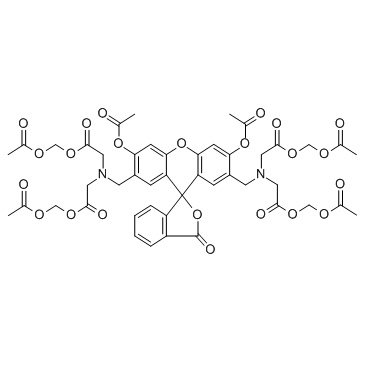Calcein-AM (Calcein acetoxymethyl ester) (Synonyms: Calcein Acetoxymethyl ester, NSC 689290) |
| Catalog No.GC34061 |
Calcein-AM (Calcein acetoxymethyl ester) is cell-permeable fluorescent dye used to determine the cell viability.
Products are for research use only. Not for human use. We do not sell to patients.

Cas No.: 148504-34-1
Sample solution is provided at 25 µL, 10mM.
Calcein-AM is a highly lipophilic vital dye that rapidly enters viable cells. It is converted by intracellular esterases to calcein that produces an intense green (530-nm) signal, and is retained by cells with intact plasma membrane.[1]
In vitro experiment it shown that calcein-AM assay used to assess human RBC viability after incubation (37°C for 3 and 20 h) in the presence of Ca2+ (2.5 mM) and ionophore A 23187 (0.5 μM).[1] 0.05 μM was the optimal concentration of CAM (Calcein-AM) for staining effector cells by testing 0.05, 0.1, 0.2, and 0.4 μM. Using 0.05 μM CAM to stain the PBMCs and expanded NK cells from three normal volunteers, the results demonstrated that there is no significant decrease in cytotoxicity and CAM staining had no significant effect on human NK cell activity in PBMCs or in expanded NK cells.[2] In vitro, 50μm calcein AM's fluorescent signal of 1 x lo5 lymphocytes was close to the saturation level, while the signal emitted by lymphocytes labeled with 20μm calcein AM was only slightly lower. [3] Calcein-AM has cytotoxic activity against human tumor cell lines (such as the human lymphoma U-937-GTB) at low concentrations (2.5 ug/ml).[4] In vitro experiment it demonstrated that in the mixed macrophages and THP-1 cells (5x105 cells/ml), Calcein-AM (2 µM)/propidium Iodide (PI) (4.5 µM) staining assay Calcein-AM/PI double staining was used to quantify the number of living and dead cells as a cell death assay.[5] In addition, The cells in OA chondrocytes were seeded in 24-well plates (2 × 104 cells/well), cultured for 4 h, the cells were treated with 5 μL Calcein-AM (2 μM) and 5 μL PI (2 μM) at 37°C in conditions void of light for 30 min, and then analyzed under a fluorescence microscope.[6]
References:
[1].Bratosin D, et al. Novel fluorescence assay using calcein-AM for the determination of human erythrocyte viability and aging. Cytometry A. 2005 Jul;66(1):78-84.
[2].Jang YY, et al. An improved flow cytometry-based natural killer cytotoxicity assay involving calcein AM staining of effector cells. Ann Clin Lab Sci. 2012 Winter;42(1):42-9.
[3].Braut-Boucher F, et al. A non-isotopic, highly sensitive, fluorimetric, cell-cell adhesion microplate assay using calcein AM-labeled lymphocytes. J Immunol Methods. 1995 Jan 13;178(1):41-51.
[4].Liminga G, et al. Cytotoxic effect of calcein acetoxymethyl ester on human tumor cell lines: drug delivery by intracellular trapping. Anticancer Drugs. 1995 Aug;6(4):578-85.
[5].Xiang N, et al. Gardnerella vaginalis induces NLRP3 inflammasome-mediated pyroptosis in macrophages and THP-1 monocytes. Exp Ther Med. 2021 Oct;22(4):1174.
[6].Zhang L, et al. MicroRNA-140-5p represses chondrocyte pyroptosis and relieves cartilage injury in osteoarthritis by inhibiting cathepsin B/Nod-like receptor protein 3. Bioengineered. 2021 Dec;12(2):9949-9964.
Average Rating: 5 (Based on Reviews and 1 reference(s) in Google Scholar.)
GLPBIO products are for RESEARCH USE ONLY. Please make sure your review or question is research based.
Required fields are marked with *




